Shakespeare - Moral Value
November/16/2016 01:21 PM Filed: Shakespeare

Credit: Brice Stratford
(Wikimedia Commons)
Shakespeare: Moral Value
“Shakespeare and the Renaissance Concept of Honor” is based on a thesis presented to Harvard University in 1950. Curtis Brown Watson divides his work into two parts. The first discusses the Renaissance idea of honor, the second addresses William Shakespeare’s use of this concept.
A good source that presents original analysis, this study is essential for students of history and English literature. Published by Princeton University Press in 1960, the text is important to understand the definition of honor in Shakespeare’s time and encourages the scholar to develop an independent interpretation of the playwright’s work.
Watson provides a list of seven critical approaches in “Foreword to Part II: Does Drama Have a Moral Function?” He invites us to judge which position has the greatest relevance.
7. “It is impossible to understand Shakespeare if one does not consider the moral values which gave his plays their structure and meaning. In Shakespeare there is a profound interpenetration of moral and of aesthetic values.”
Watson believes any attempt to separate Shakespeare from the time in which he lived while analyzing the playwright’s work will lead to invalid statements and a thesis based on present attitudes and contemporary class structure. Moral issues pertaining to English Renaissance society cannot be ignored.
Women were not permitted to appear on stage, much less allowed to interpret a writer’s words, or assume the duties of a man. Today, women perform and critique Shakespeare in great numbers, revitalizing our perspective. Feminism has modernized literary criticism, making it impossible to stay within the moral values of the Renaissance.
Shakespeare - Allegory and Symbolism
November/10/2016 04:29 PM Filed: Shakespeare

Credit: Brice Stratford
(Wikimedia Commons)
Shakespeare: Allegory and Symbolism
“Shakespeare and the Renaissance Concept of Honor” is based on a thesis presented to Harvard University in 1950. Curtis Brown Watson divides his work into two parts. The first discusses the Renaissance idea of honor, the second addresses William Shakespeare’s use of this concept.
A good source that presents original analysis, this study is essential for students of history and English literature. Published by Princeton University Press in 1960, the text is important to understand the definition of honor in Shakespeare’s time and encourages the scholar to develop an independent interpretation of the playwright’s work.
Watson provides a list of seven critical approaches in “Foreword to Part II: Does Drama Have a Moral Function?” He invites us to judge which position has the greatest relevance.
6. “Part of Shakespeare’s greatness lies in his ambiguity. Therefore we can consider his plays a rich mine for a wide variety of interpretation of ‘meaning’ and ‘pattern.’ The critic should seek for allegory and symbolism and thus discover meanings which will be suggestive, though not necessarily definitive or final.”
Not everyone values vagueness. For a critic, an ambiguous work is a blank page waiting to be filled. The more interpretations that can be gleaned from a play, the better it is for an academic. Some scholars carry this procedure to an extreme, reaching for symbols and allegories where none exist.
All literature is potentially ambivalent. Life itself is contradictory with hidden meaning. A savvy reader must be aware that every piece of criticism is as much a statement of the pundit’s personality as it is a valid interpretation.
The lack of finality, the never-ending hashing over of any writer’s words, does nothing but provoke new criticism and encourage new scholars. As time passes, the accumulation of material on Shakespeare has become overwhelming, even intimidating, giving the impression that his work is incomprehensible to the majority. Shakespeare wrote for the majority. It is only today that he has been classified as a literary, opposed to a commercial, playwright. Looking for meanings that are suggestive, though not definitive, is an activity engaged in by colleges and universities.
Shakespeare - Meaning and Interpretation
November/08/2016 02:19 PM Filed: Shakespeare

Credit: Brice Stratford
(Wikimedia Commons)
Shakespeare: Meaning and Interpretation
“Shakespeare and the Renaissance Concept of Honor” is based on a thesis presented to Harvard University in 1950. Curtis Brown Watson divides his work into two parts. The first discusses the Renaissance idea of honor, the second addresses William Shakespeare’s use of this concept.
A good source that presents original analysis, this study is essential for students of history and English literature. Published by Princeton University Press in 1960, the text is important to understand the definition of honor in Shakespeare’s time and encourages the scholar to develop an independent interpretation of the playwright’s work.
Watson provides a list of seven critical approaches in “Foreword to Part II: Does Drama Have a Moral Function?” He invites us to judge which position has the greatest relevance.
5. “The ‘meaning’ of Shakespeare’s plays changes in accordance with the preconceptions and bias of each new generation of readers. The ‘meaning’ is subjective, not objective.”
Every academic since the English Renaissance has sought meaning in Shakespeare’s work. All find it, and all are right, from a limited standpoint. When a critic searches for a message, a moral, or a purpose in a piece of literature, the quest will lead to a treasure. This treasure may be self-created, but it has value to those who respect literary analysis.
A new generation brings a fresh outlook on life, applied to everything from food to Shakespeare. A so-called objective reader is filled with ideas and attitudes that color the material, and when this work is filtered through a selected lens, distortions, both good and bad, result.
This process is comparable to a cameraman regarding a scene he wants to film for a specific reason. He will choose an angle, add or remove light, and often apply a filter to create the desired effect. In the end, this scenario will be the cinematographer’s work of art, not a naked view of what he captured with his camera.
All criticism of Shakespeare is subjective, based on cultural, religious, and educational background.
Shakespeare - Tragedy and Religion
November/03/2016 01:45 PM Filed: Shakespeare

Credit: Brice Stratford
(Wikimedia Commons)
Shakespeare: Tragedy and Religion
“Shakespeare and the Renaissance Concept of Honor” is based on a thesis presented to Harvard University in 1950. Curtis Brown Watson divides his work into two parts. The first discusses the Renaissance idea of honor, the second addresses William Shakespeare’s use of this concept.
A good source that presents original analysis, this study is essential for students of history and English literature. Published by Princeton University Press in 1960, the text is important to understand the definition of honor in Shakespeare’s time and encourages the scholar to develop an independent interpretation of the playwright’s work.
Watson provides a list of seven critical approaches in “Foreword to Part II: Does Drama Have a Moral Function?” He invites us to judge which position has the greatest relevance.
4. “Religious values are absent from Shakespearean tragedy since the tragic view and the religious view are incompatible.”
One issue that makes the tragic view and the religious view incompatible is suicide. From a Christian standpoint, killing oneself is a sin, inconsistent with church doctrine. Self-destruction depicted as noble or admirable is perceived as the ultimate cowardice. In this sense, a tragedy cannot be religious in the Western world.
Since most critics who analyze Shakespeare are Western in culture and belief, the term “religious” will often be synonymous with “Christian.” The tragic element can be lessened if a writer approaches the suicidal character with condemnation, yet Shakespeare was not inclined to do this. He presents a story in a straightforward manner without judging every action, making a scriptural view difficult to maintain.
Shakespeare - Christianity and the Renaissance
November/01/2016 04:05 PM Filed: Shakespeare

Credit: Brice Stratford
(Wikimedia Commons)
Shakespeare: Christianity and the Renaissance
“Shakespeare and the Renaissance Concept of Honor” is based on a thesis presented to Harvard University in 1950. Curtis Brown Watson divides his work into two parts. The first discusses the Renaissance idea of honor, the second addresses William Shakespeare’s use of this concept.
A good source that presents original analysis, this study is essential for students of history and English literature. Published by Princeton University Press in 1960, the text is important to understand the definition of honor in Shakespeare’s time and encourages the scholar to develop an independent interpretation of the playwright’s work.
Watson provides a list of seven critical approaches in “Foreword to Part II: Does Drama Have a Moral Function?” He invites us to judge which position has the greatest relevance.
3. “The Renaissance was a Christian age. Therefore Shakespeare, like every other writer of his age, must have been profoundly influenced by Christianity.”
Since Christianity had a tight hold on the morals of the Renaissance, often counterproductive to advancement in the arts and sciences, Shakespeare would have felt an inhibiting impact. The conflicts of the Reformation would have helped him portray interesting, diverse characters and tension-filled scenes, but the church would have been a hindrance, not an aid, to creative achievement. As he wrote, he sought ways to express himself without offending people or inviting censorship.
Euphemism, an affected though ornate way of writing, was one stylistic method. John Lyly started this tradition. Shakespeare learned from Lyly and applied this technique. Although the use of flowery, suggestive phrases with a distinct, rhythmic sound is far more pronounced in Lyly’s plays and novels, its application in Shakespeare’s material is noticeable. Euphemism made it possible for a playwright to say anything, even describe sexual acts, by the strategic placement of words. Only the educated would have understood, one reason why no one stopped careful writers in an age of prudish restraint.
Scholars who incorporate religious beliefs in the interpretation of Shakespeare’s work are making a mistake. In the development of a scene, Shakespeare would have been capable of seeing a situation from the viewpoint of a Christian or an atheist based on the needs of his plot.
Shakespeare - Philosophical Value
October/27/2016 11:25 PM Filed: Shakespeare

Credit: Brice Stratford
(Wikimedia Commons)
Shakespeare: Philosophical Value
“Shakespeare and the Renaissance Concept of Honor” is based on a thesis presented to Harvard University in 1950. Curtis Brown Watson divides his work into two parts. The first discusses the Renaissance idea of honor, the second addresses William Shakespeare’s use of this concept.
A good source that presents original analysis, this study is essential for students of history and English literature. Published by Princeton University Press in 1960, the text is important to understand the definition of honor in Shakespeare’s time and encourages the scholar to develop an independent interpretation of the playwright’s work.
Watson provides a list of seven critical approaches in “Foreword to Part II: Does Drama Have a Moral Function?” He invites us to judge which position has the greatest relevance.
2. “Since Shakespeare was not a philosopher, he was not concerned with questions of value.”
Shakespeare explored questions of value as they relate to his plays and the portrayal of his characters. Even a story that attempts to avoid any philosophical statement makes one in the act of refraining. It is impossible for a writer to put an idea to paper without consciously or subconsciously weaving buried notions and perceptions into the fabric of the plot. A playwright might make a divergent assertion, or through the vivid depiction of a protagonist, take a social stance.
The tougher the character—the stronger the impact—the deeper the meaning. Scholars may disagree on what his connotations imply, but messages are threaded throughout Shakespeare’s dramatic words. Like fine gold filament that catches the eye, his hidden nuances invite philosophical pondering.
Shakespeare - Point of View
October/25/2016 10:38 PM Filed: Shakespeare

Credit: Brice Stratford
(Wikimedia Commons)
Shakespeare: Point of View
“Shakespeare and the Renaissance Concept of Honor” is based on a thesis presented to Harvard University in 1950. Curtis Brown Watson divides his work into two parts. The first discusses the Renaissance idea of honor, the second addresses William Shakespeare’s use of this concept.
A good source that presents original analysis, this study is essential for students of history and English literature. Published by Princeton University Press in 1960, the text is important to understand the definition of honor in Shakespeare’s time and encourages the scholar to develop an independent interpretation of the playwright’s work.
Watson provides a list of seven critical approaches in “Foreword to Part II: Does Drama Have a Moral Function?” He invites us to judge which position has the greatest relevance.
1. “Shakespeare was an objective dramatist who tried to describe every aspect of the human scene without committing himself to the point of view of any of his dramatic creations.”
Although Shakespeare may have written objectively, it would have been impossible to portray a character without committing himself to a point of view. Understanding the motivation behind a protagonist’s actions is essential to a playwright’s success. This does not mean that a writer must empathize with a villain, but lifelike presentation involves the ability to understand the reasons behind immoral behavior.
Shakespeare portrayed historical and tragic figures with realism. He desired to make these remote individuals accessible for the duration of a play. The average theater patron of the Renaissance went to see his productions for the entertainment alone. If Shakespeare had not committed himself to the viewpoints of his notable characters, his fame would have been short-lived.
Literary Perspective - Symbolism
October/13/2016 01:29 PM Filed: Literary Perspectives

Credit: Outlook Co.
(Wikimedia Commons)
Symbolism
A literary symbol is a material object that takes on psychological significance, whereas a metaphor involves the comparison of an entity, a place, or an event to a personality or a character’s behavior. Critics agree on definition, but an individual may evaluate a work of fiction and come up with a unique opinion, rather than a written-in-stone analysis.
In a story, the protagonist makes decisions influenced by the dominance of this symbol.
Literary Perspective - Women in Rebellion
October/13/2016 11:11 AM Filed: Literary Perspectives
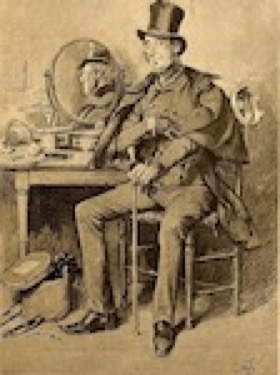
Credit: E. Hess
(Wikimedia Commons)
Women in Rebellion
As the women’s movement progressed from gaining the right to vote to acquiring freedom to pursue a career, reactions to equal status have not always been positive. Stereotypical problems include difficulty in combining a job and motherhood, fear of losing femininity, and desire to cling to indoctrinated roles.
Strangely, a woman sometimes rebels against patriarchal authority by rejecting independence rather than accepting it. Every decade she fights new battles and acquires political ground, while a traditional archenemy yanks her back.
In feminist literature, a patriarch can be any man—a minister, a father, a husband—even men in general. Although the device may be overdone, this technique is effectively used to address sensitive gender issues. In fiction, as in life, women can be their own worst enemies by not communicating, leading to lack of courage and assertiveness.
Literary Perspective - Quest for Cupid
October/13/2016 10:52 AM Filed: Literary Perspectives
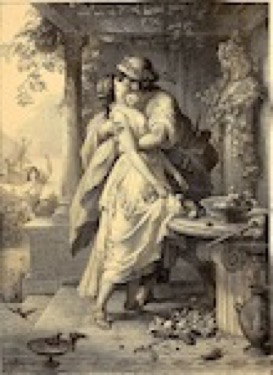
Credit: E. Hess
(Wikimedia Commons)
Quest for Cupid
Women in pursuit of affection have controlled romance fiction throughout the centuries. Although the hero appears to dominate stories, it is the heroine who manipulates plot. At the heart of the female sexual fantasy is a desire for exclusivity, or at least, that’s what women have been taught. In certain situations, this belief can be proven incorrect, but that stereotypical assumption is usually taken for granted.
The quest for a lover’s mind, body, and soul supports the foundation of matrimony. A contemporary, legally binding relationship is a partnership, and perhaps, an ideal environment to raise children. Few educated couples want the right to possess each other, but this psychological drive persists, a throwback to the past.
Tension between illusion and reality causes conflict between an individual’s perceived and actual world. When expectations remain unfulfilled, fantasy takes over. Fantasy is a psychological safety valve that routes disillusionment into a comfortable, soothing place. Some call this an inner light, while others describe it as mere daydreaming.
Epiphanies rarely involve unconditional love. When a character’s behavior appears altruistic during a revelation, motivating factors tend to be self-glorifying, often defensive. Even in progressive countries like the United States, social transitions are never immediate. Romance novels reflect an ongoing period of adjustment and adaptation.
Literary Perspective - Turbulence Beneath the Calm
October/13/2016 10:32 AM Filed: Literary Perspectives
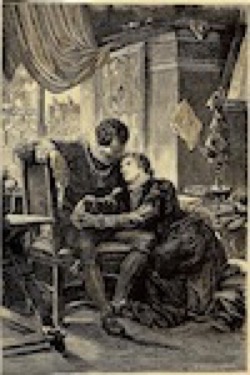
Credit: E. Hess
(Wikimedia Commons)
Turbulence Beneath the Calm
Women in transition are often portrayed with a calm demeanor in literary stories. Disputes remain low-key or nonexistent, unlike mass-market fiction in which arguments escalate to violence. These scenarios present exaggerations, inaccurate illustrations of reality, but skilled authors know the importance of achieving dramatic effect through understatement.
Beneath a quiet, unassuming woman lingers a passionate side she keeps concealed due to the dictates of society. Underlying turbulence within placid, easygoing heroines is a common device to counteract hysterical, drug-subdued portrayals. A high-strung woman meets disrespect unless her anxiety-driven personality is career-oriented.
In the past, creative energy could not be focused on a professional endeavor because it undermined a woman’s responsibility as a nurturer and caregiver. In contrast, men are frequently depicted suffering from neurosis, while an uncaring woman lurks nearby. Neither role is appealing.
Literary Perspective - Searching for Individuality
October/13/2016 10:14 AM Filed: Literary Perspectives
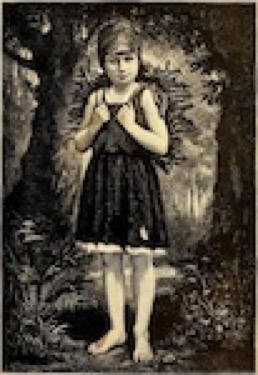
Credit: E. Hess
(Wikimedia Commons)
Searching for Individuality
The most difficult time in an adolescent’s life is finding a sense of identity in a world governed by overwhelming adult influence. A teenager feels pressure from parents and teachers to establish a “self” not far from the norm established by family and school. If Dad loves football, his son is expected to enjoy the sport. If Mom is a nurse, her daughter is encouraged to join the profession with enthusiasm.
This is not the pattern that life usually takes. Self-discovery often leads to loss of approval from an authority figure, followed by rebellion and impulsive mistakes. The damage done—sometimes permanent—destroys relationships and even lives.
Childhood impressions are indelible ink on the canvas of the mind. The protagonist acts on past experiences and aspires to higher goals or remains within the confining social structure defined in youth. A teen emerges from a struggling, often poor background to form a conclusion, make a transition, or set a course of action.
A good story establishes a sense of identity within the developing mind of a young adult. Ideally, this realization leads to social integration, emotional stability, and finally, maturity.
Literary Perspective - Psychological Drama
October/12/2016 10:38 PM Filed: Literary Perspectives

Credit: Gabriel Gaston Context Croft
(Wikimedia Commons)
Psychological Drama
Imagination is a psychological distraction and a method of creation. When reality falls short of expectation, the inventive part of the intellect takes over and explores alternatives to this unacceptable situation. Some call it brainstorming, a developmental procedure that can be examined and displayed on a whiteboard. The mystery diminishes under sober scrutiny, but the art of creating can be taught. Few begin with a blank slate, which would be similar to starting with a blank mind. Every conceptualized scenario has its inherent makeup, just like a human is a complex network of genes.
An author uses this discovery process to write fiction. Within a distant realm of the brain is a womb where characters and settings are conceived. Psychological drama can be lighthearted or serious, depending on mood and temperament. Background, religion, and education contribute to the style and tone.
The merging of fantasy and reality is at the core of the paranormal story. Mass-market analysts assert that a story is purely entertainment. Readers of commercial fiction do not consult study guides to comprehend a hidden symbol, nor does a movie theater audience probe a film’s inner message. Being oblivious, however, does not mean the profound reason for creation is nonexistent. Differences exist in the quality of the finished work, but every writer redefined the world within a unique plot line.
Literary Perspective - Characters of the Mind
October/12/2016 03:14 AM Filed: Literary Perspectives
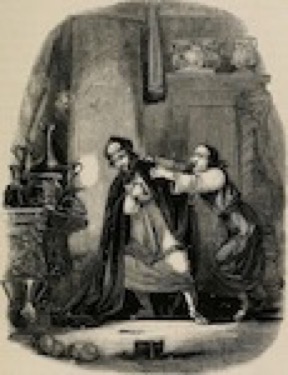
Credit: Chapman and Hall
(Wikimedia Commons)
Characters of the Mind
Aliens, ghosts, and monsters make a regular appearance in science fiction and horror stories. Interest will not wane as otherworldly entities manifest themselves. What makes creators of paranormal plots successful?
Their secret lies in the ability to frighten and enlighten. Excursions into unknown recesses of the brain form the basis for intelligent literature in all periods. Excitement the adult experiences when watching a horror movie may not be suitable for children, but ironically, subject matter that educated censors consider inappropriate in a cinema may be praised in an English classroom.
At the end of a film, the viewer realizes the tale was mere entertainment and shrugs off uncomfortable and unfamiliar concepts, yet at the end of a literature course, the student walks away with changed beliefs about this world and other realms that may exist, even if this controversial place is only a figment of the imagination. Characters of the mind reside within this elusive psychological setting, symbols of repressed emotions and buried needs.
This rift between drama and literature has been present for centuries. In the early days of stage performances, the church frowned on deviant attitudes presented in plays before the masses. The condemnation resulted in suppression of creativity, a futile shot at thought control. Ingenious writers found allegorical and euphemistic ways around state and clerical restrictions.
In contemporary society, authors exercise freedom of expression, even if the process of conception scares someone. A hidden message emerges from every unexpected, illusory visitor. Attempts at smothering feelings such as fear, and refusing to acknowledge forbidden desire, lead to a stronger manifestation of the emerging character.
The protagonist struggles with an unrecognized problem, wish, or belief. A supernatural being wins the battle and makes an appearance. An astute writer demonstrates ability to reach the heart of the disturbance.
Literary Critique - Aura
September/29/2016 02:43 PM Filed: Literary Critiques

Photo Credit: Abderrahman Bouirabdane
(Wikimedia Commons)
Altered Consciousness and Supernatural Phenomena
Published in 1962, during a decade obsessed with youth, “Aura” by Carlos Fuentes is a psychological thriller with occult undertones. Felipe Montero, a historian, responds to a newspaper ad for a job. An elderly matriarch hires him to write the memoirs of her deceased husband. Felipe is required to live with her during the course of the project.
Aura is the matriarch’s niece, a beautiful, young caregiver. Felipe falls in love with her and engages in a romantic relationship. Then threatening visions intermingle with bizarre behavior. The strange affair progresses, and Felipe notices similarities between Aura and the old woman as this spine-tingling tale spirals into madness.
Fuentes writes, “…a ray of moonlight shines in and surprises you, shines in through a chink in the wall that the rats have chewed open, an eye that lets in a beam of silvery moonlight. It falls on Aura’s eroded face, as brittle and yellowed as the memoirs, as creased with wrinkles as the photographs… You love her, you too have come back…”
The creepy, second-person viewpoint lends a Gothic tone. This supernatural story addresses the common fear of getting old.
In Fuentes’ plot, it is the paranormal presence of a ghost brought to life through time-altering immersion in a woman’s memories that acts as the catalyst. A cross between literary drama and commercial horror, “Aura” remains a fantasy subject to interpretation.
Literary Critique - What We Talk About When We Talk About Love
September/17/2016 10:00 AM Filed: Literary Critiques

Photo Credit: Unknown
(Goodreads)
An Unromantic Epiphany
In Raymond Carver’s 1981 story, “What We Talk About When We Talk About Love,” a group of friends discuss domestic violence and the meaning of love over gin and tonic.
The most significant character is Terri, a woman deluded into believing her ex-boyfriend beat her because he loved her. Rather than behaving as a victim and accusing the abuser of harming her, she condones his actions in the mistaken notion that the more passionate the relationship, the rougher the lover.
Terri’s husband remarks, “Terri’s a romantic. Terri’s of the kick-me-so-I’ll-know-you-love-me-school.”
Carver may not have wanted to induce laughter when he created this sidekick of a spouse, but these two characters bounce dialogue off each other in a deadpan, humorous delivery. Eventually, her destructive ex committed suicide. “It was love,” Terri said. “Sure, it’s abnormal in most people’s eyes. But he was willing to die for it. He did die for it.”
Terri exhibits masochistic tendencies and cannot accept the reality that hatred is associated with physical abuse, not love. Perhaps she adored her ex-boyfriend and couldn’t handle his possessiveness outbursts without rationalizing.
Literary Critique - A New England Nun
September/14/2016 09:00 AM Filed: Literary Critiques
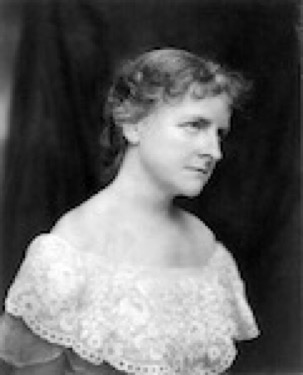
Photo Credit: Floride Green
(Wikimedia Commons)
Solitary Contentment and 19th-Century Feminism
Mary Eleanor Wilkins Freeman portrays Louisa, a single woman who has waited fifteen years for her fiancé to acquire his wealth in Australia. Usually, these fortune hunters never return, but Joe does, creating deep turmoil when he walks back into her life.
Published in 1891, “A New England Nun” depicts a lonely woman on the surface, but beneath the isolated facade is an independent lady content to live by herself. Louisa cannot admit that she doesn’t want marriage. The story is an inner struggle as she wars with opposing concepts of family and autonomy. In the 1800s, a woman could not simultaneously maintain her independence and wed, so it is a choice, not a matter of integrating the two.
Freeman makes fun of her standoffish character in subtle ways. Throughout this piece, sarcasm manifests itself in descriptions, allusions, and jabs: “A little yellow canary that had been asleep in his green cage at the south window woke up and fluttered wildly, beating his little yellow wings against the wires. He always did so when Joe Dagget came into the room.”
When Louisa is alone the bird is so bored he sleeps, but the sight of Joe rouses the canary to the point of fluttering excitement. This alludes to dormant sexuality attempting to escape the confines of a sheltered existence in a prim and proper home. The pet is strategically placed in an important scene, and Freeman calls attention to this activity like an aside delivered from a stage.
In the last paragraph, Freeman loses patience with her own protagonist and writes, “She gazed ahead through a long reach of future days strung together like pearls in a rosary, every one like the others, and all smooth and flawless and innocent, and her heart went up in thankfulness. Outside was the fervid summer afternoon; the air was filled with the sounds of the busy harvest of men and birds and bees; there were halloos, metallic clatterings, sweet calls, and long hummings. Louisa sat, prayerfully numbering her days, like an uncloistered nun.”
An afternoon filled with bustling activity is symbolic of the life Louisa has chosen not to pursue. Although Freeman has not overtly condemned this heroine for rejecting marriage, she expresses distaste for Louisa’s decision to do nothing but number her remaining days without a partner.
The idea of blissful matrimony is a fantasy. Louisa’s reality is her seclusion.
Literary Critique - Sunday in the Park
September/12/2016 02:19 PM Filed: Literary Critiques

Photo Credit: Unknown
(Goodreads)
Apathy and Passive Nonchalance
Written in 1983, Bel Kaufman’s “Sunday in the Park” depicts a married couple and their son Larry enjoying an afternoon at a playground. When a bully throws handfuls of sand at their child, an unusual incident occurs. No one does anything to stop it. The bully’s father will not reprimand his son and encourages a fight. The victim’s father choses to leave with Larry rather than confront an intimidating man who will beat him up.
Sounds like a simple case of fight or flight. Morton flees. This doesn’t go over well with his wife. Embarrassed about Morton’s inability to resolve the problem, she defines this seemingly insignificant event as an indicator of a troubled relationship. Larry cries as they leave the park, and the disgusted parents debate how to handle, or perhaps even discipline, their child’s outrage and unrelenting display of emotion.
Kaufman writes, “Her first feeling was one of relief that a fight had been avoided, that no one was hurt. Yet beneath it there was a layer of something else, something heavy and inescapable. She sensed it was more than just an unpleasant incident, more than defeat of reason by force.”
This powerful story portrays a woman dissatisfied with her husband’s personality. This protagonist turns a disturbing event into a statement of all that is wrong in her marriage, while remaining strangely composed.
Literary Critique - Separating
September/07/2016 05:40 PM Filed: Literary Critiques

Photo Credit: Dennis Kan
(Wikimedia Commons)
Defining Marriage in Modern Society
John Updike’s “Separating” is the story of a stereotypical family torn apart by a couple’s decision to part company after many years of marriage. Published in 1975, Updike approaches divorce with the nonchalance of the decade, but beneath his laid-back delivery is subtle condemnation.
It’s not clear which party is at fault even though Richard, the protagonist, is seeing another woman. Joan, his wife, is concerned about the children, but no longer particularly worried about her spouse moving out. They appear to want an open marriage more than they want to disrupt the family.
The narrative is told from Richard’s viewpoint: “His wife slept as if slain beside him.”
He may blame Joan’s waning passion for their breakup, but his disturbed, neurotic behavior manifests itself in any situation with his children when he is expected to announce his desire to leave. Though his wife’s viewpoint is nonexistent, her “sleeping” presence in the background can be felt as the catalyst, implying that Joan chose to end her marriage long before Richard decided to have sex elsewhere. Other than fatigue, the reason is not disclosed.
Updike is poking fun at holy matrimony as well as the concept of religious sacrament. Embedded in his plot is an important reminder to uphold the contemporary legal definition. Marriage is a domestic partnership, not an archaic ritual.
Literary Critique - The Lesson
September/06/2016 04:07 PM Filed: Literary Critiques

Photo Credit: Unknown
(Wikipedia)
The Individual and Social Disparity
In Toni Cade Bambara’s 1972 story, “The Lesson,” an eccentric heroine takes upon herself the responsibility of mentoring a group of underprivileged children in her neighborhood. Educated and always dressed well, she inspires and annoys. She’s scoffed at and talked about, yet respected. Narrated by one of the children, now an adult reminiscing, this parable is told from a first person viewpoint.
Miss Moore teaches the value of the dollar and the importance of working toward worthwhile goals. Encouraging these kids to look at everything they cannot afford in a toy store, they decide whether an item is priced correctly. Figures seem exorbitant while examining numerous items with interest.
She ends this provocative visit with an inquiry, allowing these students to determine the fairness in social disparity. The reaction she receives is more than mere childhood longing and fantasy.
Sugar, the narrator’s companion, responds, “Equal chance to pursue happiness means an equal crack at the dough, don’t it?”
At this point, Sugar realizes she wants an opportunity to acquire material possessions only the “other half” can afford. With the right guidance, she will choose education.
Literary Critique - Looking for Mr. Green
September/02/2016 04:13 PM Filed: Literary Critiques

Photo Credit: Keith Botsford
(Wikimedia Commons)
The Quest for Identity
Published in 1951, Saul Bellow’s “Looking for Mr. Green” is the story of George Grebe, a government worker, and his quest for an elusive Mr. Green. Grebe delivers relief checks to homebound people in need. Set in inner-city Chicago, Bellow portrays a community struggling with poverty.
Mr. Green is a symbol of the downtrodden man with no real identity. No one knows him, and no one cares. Throughout the narrative, Grebe searches for a person who may not even exist. Every clue leads to nothing. Every lead takes him nowhere.
Bellow writes, “Why is consent given to misery? And why so painfully ugly?”
Though benevolent society tries to help the poor, attempts often fail due to interference. Before this money will reach the mysterious Mr. Green’s hands, numerous people will try to protect him from the law, or what can be perceived as unwanted government intervention. This may be Bellow’s message.
Literary Critique - The Demon Lover
August/30/2016 03:51 PM Filed: Literary Critiques

Photo Credit: Unknown
(Wikipedia)
A Vision of Distorted Reality
Published in 1945, “The Demon Lover” by Elizabeth Bowen portrays a distraught woman facing a serious mistake. While out of touch with reality, Kathleen Drover promises to wed a soldier on his return from World War I. Without getting to know him or even seeing his features clearly, she commits herself to a future marriage. He disappears and is presumed dead, then returns twenty-five years later to force her to honor her promise.
This is where the story begins and where her vision of reality changes. Using a strategically placed letter along with stealth, he traps her in a taxicab and drives off with her. His face is never described, but Kathleen’s reaction is one of terror when she looks at him.
This is where the story ends and where her distorted reality begins.
Bowen writes, “He was never kind to me, not really. I don’t remember him kind at all. Mother said he never considered me. He was set on me, that was what it was—not love.”
Even after the passage of another war, Kathleen’s supernatural abductor exercises what he believes is his right to claim her. Although she has never waited for his return because she didn’t realize he was coming back, their relationship picks up where it left off.
Kathleen is alone throughout the story. Her family’s London residence is damaged, and she’s come to collect possessions. The protagonist may believe she’s haunted, or the ghost in the cab could be an innocent driver she fears will harm her. Bowen implies that the experience is psychic, a stress-induced reaction to the trauma of war.
Literary Critique - The Girls in Their Summer Dresses
August/22/2016 02:01 PM Filed: Literary Critiques

Photo Credit: Willem van de Poll
(Wikimedia Commons)
Irwin Shaw and Sexual Domination
In his 1939 short story, “The Girls in Their Summer Dresses,” Shaw portrays a sexually compatible couple discussing their night together. Initially, nothing appears wrong until possessiveness emerges. Frances is an old-fashioned clinging vine concerned about her lover’s roving eye. She pursues Michael, interrogating him about every glance and affectionate appraisal he’s directed at another woman.
Although Frances claims she slept wound around him like a rope, a liberty he permits only on Saturday when the week’s work is done, this insecure heroine isn’t getting enough of something. She needs reassurance that Michael will never feel attracted to anyone else, reassurance he cannot give. He admits to appreciating beauty. Blatantly heterosexual, Michael refuses to hide his desire to look at women as they pass him on the street. In contrast, she claims she hasn’t looked at another man since their second date.
At the conclusion, Frances is crying. Her reaction is stereotypical, yet behind her sadness is a frustrated sense of challenge and a desire to possess Michael to the extent of controlling his thoughts. Her attempt to “lock him in,” much like a real estate agent would close a deal, will lead to one negative result: the end of their relationship. Once Frances reaches her destination, complete domination of Michael, she will lose interest.
Literary Critique - Wine
August/19/2016 02:26 PM Filed: Literary Critiques

Photo Credit: Elke Wetzig
(Wikimedia Commons)
The Intoxication of Symbolism
In Doris Lessing’s “Wine,” a story published in 1957, a man relates his rejection of a beautiful woman who came to him one night after they had been drinking and singing with friends. Disclosing this so-called act of honor to his present girlfriend may seem reassuring on the surface, but beneath his poignant reminiscing is sexual dysfunction and an insecure, gloating delivery.
Lessing points to the glass in his hand without stating the obvious: alcohol incapacitates. He explains that this spurned acquaintance later had a love affair with his best friend, and he hints this was just to spite him.
“She hated my guts, and I suppose she was right,” he says with false assurance.
His current girlfriend pursues a companion unobtainable in the physical sense, so his affection is given in a different form. Lessing writes, “He put the wineglass into her hands; and she lifted it, looked at the small crimson globule of warming liquid, and drank with him.”
This final sensual act is a symbolic statement of tenderness, the only way he knows to offer himself to a lover.
Literary Critique - Night Meeting
August/15/2016 03:59 PM Filed: Literary Critiques

Photo Credit: CBS Television
(Wikimedia Commons)
Ray Bradbury and Interpreted Reality
In Bradbury’s 1950 science fiction thriller, “August 2002: Night Meeting,” a space traveler meets a Martian. Neither sees what the other sees. The earthling perceives Mars as barren and deserted, no longer inhabited, whereas the Martian perceives his planet as thriving and alive. These protagonists frighten each other and struggle to comprehend a world different from their own.
The Martian states, “What does it matter who is Past or Future, if we are both alive, for what follows will follow, tomorrow or in ten thousand years.”
An altered sense of time and place has occurred, leaving the possibility open that Past and Future do not exist. Bradbury goes beyond time travel in this outstanding story, suggesting that what we think we see is not what is really there. He implies the existence of other dimensions and encourages private conclusions. The tale ends in eerie stillness with both characters attributing their visions to dreams.
Bradbury writes, “Starlight twinkled on the empty highway where now there was not a sound, no car, no person, nothing. And it remained that way for the rest of the cool dark night.”
Literary Critique - The Blue Hotel
July/29/2016 10:37 PM Filed: Literary Critiques

Photo Credit: Britannica Online Encyclopedia
(Wikimedia Commons)
Destruction of the Natural World
A Western tavern is not a typical place to make a symbolic statement, but Stephen Crane succeeds by careful placement of the protagonist. In his classic story, “The Blue Hotel,” the gambler is an unassuming man, small in stature. He doesn’t appear until the end, during a lethal confrontation with a burly interloper.
This taunting antagonist symbolizes the rugged world, picking a fight with humanity by unleashing the brutal power of Nature. The gambler stands for the common man, attempting to win the battle by using force. As the human being has tried to subdue Nature since prehistoric days, the planet has been devastated, stemming from pollution and overpopulation.
When this story was published in 1898, an Easterner would have been a sophisticated city slicker with a desire to tame and control Nature. This is a simplistic evaluation because many city dwellers are environmentalists, and the rural population can be as harmful as urbanites.
After losing a home or a loved one to a disaster, striving to harness the elements would be an understandable action. It’s the indiscriminate destruction of the natural world that must be curbed.
Literary Critique - The Fall of the House of Usher
July/22/2016 02:59 PM Filed: Literary Critiques
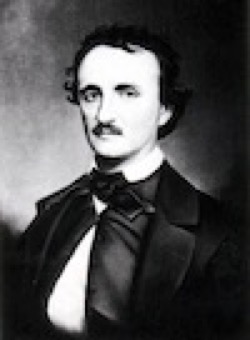
Photo Credit: Oscar Halling
(Wikimedia Commons)
Edgar Allan Poe: The Psychological Crypt
Poe creates tension in his writing by placing something or someone in the background, lurking somewhere, waiting. This technique is evident in “The Fall of the House of Usher,” a story published in 1839.
Roderick Usher cares for his sister until her presumed death. Catalepsy makes her appear dead long before she really is. Her condition causes madness in her brother, and Roderick deteriorates as this frightening tale advances. Beneath the surface, a feeling of impending doom surrounds the protagonist, advancing the plot and building suspense. A horrible event is about to occur.
Although Madeline isn’t much of a character in her near comatose state, her presence establishes a stronger personality in her brother. The emotionally distraught and unstable Roderick makes up for what is missing in Madeline.
As the narrator and Roderick look into her coffin one last time, Poe writes, “A striking similitude between the brother and sister now first arrested my attention; and Usher, divining, perhaps, my thoughts, murmured out some few words from which I learned that the deceased and himself had been twins, and that sympathies of a scarcely intelligible nature had always existed between them.”
Interpretation of this statement is subjective. Poe has created a sense of mystery. He casts a gloomy mood over the setting, far from peaceful.
After Madeline’s entombment on the estate, Roderick sees and hears what the narrator cannot perceive, at least not at first. The climax is her emergence from the crypt, bloody and exhausted, after her fight to escape. The fear of being buried alive is a horror that authors have capitalized on for centuries. Poe uses this psychological device with expert skill.
Literary Critique - Barn Burning
July/13/2016 03:36 PM Filed: Literary Critiques
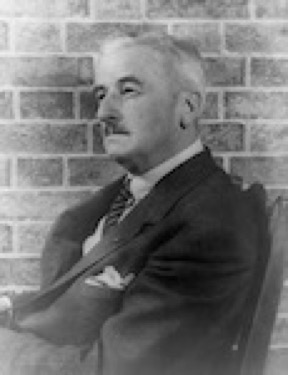
Photo Credit: Carl Van Vechten
(Wikimedia Commons)
William Faulkner and Class Consciousness
Faulkner’s portrayal of a boy torn between loyalty to his criminal father and need to protect the community is symbolic of the South’s slow progression to social justice. Like a child craving parental approval, the semi-reconstructed former Confederacy often sought the acclaim of its steadfast peers rather than make changes for the overall good of the United States.
In his 1939 story, “Barn Burning,” Faulkner named the young character after a fictional plantation owner, an educated Southern gentleman. With only Confederate interests at heart, this member of the country gentry was a hero only to his comrades.
The Union made significant attempts to control violence spurred by class differences and political power struggles, yet awareness of inequality determined status in every walk of life. Faulkner, a Nobel Prize winner, spotlighted the sad reality that the Civil War was not over. The impact of this bloody conflict disrupted the nation and placed all Americans on the defensive.
Faulkner writes, “He was a little stiff, but walking would cure that too as it would the cold, and soon there would be the sun. He went on down the hill, toward the dark woods within which the liquid silver voices of the birds called unceasing—the rapid and urgent beating of the urgent and quiring heart of the late spring night. He did not look back.”
Class consciousness is at the heart of this plot, recognition of what it is, and condemnation for what it accomplishes. In the last paragraph, Faulkner compares the sun to justice, the dark woods to slavery, and the silver voices of the birds to the emerging voices of freedom.
Literary Critique - A Jury of Her Peers
July/05/2016 03:29 PM Filed: Literary Critiques

Photo Credit: New York Public Library
(Wikimedia Commons)
Authoritarian Marriage and Early Feminism
Susan Glaspell’s 1917 story, “A Jury of Her Peers,” depicts two feminists choosing to keep evidence hidden after a neighbor hangs her abusive husband. A search of her home leads to suspicion, yet proof of Mrs. Wright’s guilt cannot be found until wives of the investigators discover a treasured canary strangled by Mr. Wright. The demure Mrs. Wright is described as lacking in vitality and life, her spouse, intolerant and controlling.
One observer relates her impression of the man to the sheriff’s wife. “No, Wright wouldn’t like the bird—a thing that sang. She used to sing. He killed that too.”
Glaspell writes of a quiet, unassuming woman who turns into a criminal, erupting like a volcano in an act of violence after years of mistreatment. This author views marriage with sardonic contempt. Glaspell asserts her outrage through her characters and portrays the investigators as dictatorial, belittling women’s interests and activities.
This plot does not resolve the problem in question, but has definite finality. The investigators’ wives hide the dead canary, evidence that could prove Mrs. Wright’s motivation. These women are this suspect’s only jury.
Literary Critique - Why I Live at the P.O.
June/27/2016 03:49 PM Filed: Literary Critiques

Photo Credit: Unknown
(Goodreads)
Eudora Welty and the Dysfunctional Family
Welty portrays a dysfunctional Southern American family in “Why I Live at the P.O.,” reminiscent of the troubled, grating regionalism present in the work of William Faulkner. Published in 1941, this story contains a toned down version of the dialect Faulkner favored to convey a character’s background and education.
With a conversational, first person delivery, the protagonist shares the embarrassing details of her life, but cannot be classified as an antihero. Her family argues, each petty problem worse than the last. The bickering is obnoxious. A harsh cacophony of words indicates a power struggle is taking place, sibling rivalry the catalyst.
As this clash intensifies, she determines she’ll be safer and happier living at the post office, her place of employment. The narrator’s personality is a result of her upbringing in a stressful environment. None of these characters have matured emotionally, and even her older relatives exhibit childish dispositions.
Welty’s candid tale touches on serious domestic strife, yet entertains like a confession magazine piece.
Literary Critique - The Man Who Was Almost a Man
June/22/2016 04:17 PM Filed: Literary Critiques

Photo Credit: Carl Van Vechten
(Wikimedia Commons)
A Dangerous Symbol of Masculinity
In “The Man Who Was Almost a Man,” a story published in 1940, Richard Wright introduces a protagonist who wants a gun. Although family and acquaintances oppose his wishes, he manages to acquire one for two dollars. The gun symbolizes strength and virility to this character, and he mistakenly believes that owning one will make him more of a man.
During his first experimental handling of the weapon, he accidentally shoots a neighbor’s mule. Wright’s vivid description of the animal’s death at the hands of her killer indicates the gunman regrets his clumsy action and wants to cover it up.
When questioned by the owner, he claims the mule fell on the joint of a plow. He buries the weapon, but later reclaims it and jumps onto a passing train, bound for an unknown destination.
“He hesitated just a moment; then he grabbed, pulled atop of a car, and lay flat. He felt his pocket; the gun was still there. Ahead the long rails were glinting in the moonlight, stretching away, away to somewhere, somewhere where he could be a man…” Wright shows the spiritual unrest within this character. “He turned over, thinking how he fired the gun. He had an itch to fire it again.”
In this excerpt, Wright reveals an inner struggle. The gunman talks himself into asserting his manliness by going after the most dangerous symbol of power: a firearm.
Literary Critique - The Grave
June/20/2016 05:37 PM Filed: Literary Critiques

Photo Credit: Unknown
(Wikipedia)
A Symbol of Life
Published in 1944, “The Grave” by Katherine Anne Porter is a story about a brother and sister venturing into an opened family cemetery after remains have been transferred to a new plot. As the children climb into the empty pits, they discover themselves and pieces of jewelry left behind. Although the subject seems morbid, guided by curiosity and fueled by fear, the message leaves the reader with the feeling that a psychological resolution has taken place.
The siblings swap a gold ring and a silver dove, each finding the other treasure more appealing than the one retrieved. Nine-year-old Miranda takes the ring, and twelve-year-old Paul takes the dove.
Significant is the scene that follows when Paul shoots a pregnant rabbit after receiving the trinket from his sister. On slicing the rabbit open, they find the animal’s dead babies. This has a powerful impact on Miranda. At that moment she recognizes her own ability to conceive, and the human being’s ability to extinguish life. The children choose to bury the carcass with the kits wrapped in her skin.
Memories of her family’s grave will always be linked to the symbol of peace Miranda gave Paul and the mother rabbit. This is a revelation, associated with the scent and sight of the hole in the ground, and the rabbit’s unborn offspring. This childhood experience has left Miranda with a promise of renewal and life.
Literary Critique - I Stand Here Ironing
June/17/2016 02:40 PM Filed: Literary Critiques

Photo Credit: Unknown
(Wikipedia)
Poverty and Social Intervention
Tillie Olsen’s 1961 story, “I Stand Here Ironing,” sounds mundane, but Olsen has presented a troubled mother-daughter relationship buried beneath the clothes that need pressing. As this mother goes about her housework, she tells of daughter Emily’s difficult childhood. Portrayed as an asthmatic, underweight waif with psychological problems, this girl is a talented winner in disguise. Her onstage performing abilities are not recognized until later.
The frustration and sadness behind Emily’s behavior are not evident until she is a teenager. “My wisdom came too late. She has much to her and probably little will come of it. She is a child of her age, of depression, of war, of fear.”
Although the root of Emily’s trouble appears to be poverty, her downtrodden parent attributes the girl’s struggling past to circumstances beyond anyone’s control. Significant is this mother’s reaction to her daughter acquiring red measles. Emily does not recover and must be sent to a convalescent home where the child can receive better care than provided at home.
This is not the case, however, since Emily cannot keep possessions. Cards and letters are discarded because the facility does not have room to keep a patient’s items. Instead of convalescing, Emily gets thinner and sicker, refusing to eat food poorer in quality than what she would have received in her own kitchen.
When a social worker agrees to release her after eight months, Emily is physically and mentally scarred. In the end, nothing can take away the pain this intelligent girl has experienced.
Literary Critique - King of the Bingo Game
June/14/2016 01:20 PM Filed: Literary Critiques
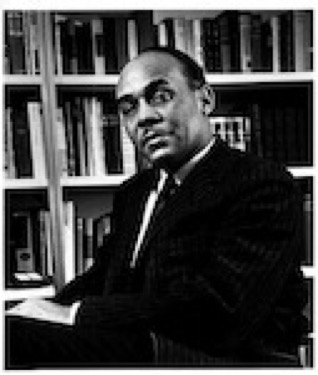
Photo Credit: United States Information Agency
(Wikimedia Commons)
Gambling with a Higher Power
Ralph Ellison’s “King of the Bingo Game” was published in 1944. The narrator is distraught at the beginning of the story. Laura, a woman close to him, needs medical attention and money. The narrator, presumably her husband or lover, is determined to get it by playing bingo. When he wins his chance to spin the wheel for the jackpot, he becomes delusional about its power and cannot stop spinning it.
The wheel is a symbol of God. In the hands of this desperate man, it takes on supernatural strength. The narrator believes God will intervene as long as it keeps turning, and in the end, Laura will be healed. His aversion to letting the wheel stop indicates his fear of losing touch with this higher power if the outcome is not what he anticipates. As long as it keeps spinning, he feels safe, assured of its ability to help Laura.
From a psychological standpoint, this man is unstable. He suffers from obsessive-compulsive disorder, and in this bingo hall, he is having a nervous breakdown. Laura’s illness and the threat of her death have unhinged him to the point of madness. He must be removed from the stage. Just as physical force is used against him, the wheel stops at double zero, indicating he would have won.
Ellison writes, “He only felt the dull pain exploding in his skull, and he knew even as it slipped out of him that his luck had run out on the stage.”
The use of excessive, knockdown force at the end alludes to the difficult transition after the Civil War when some African Americans were subjected to brutal restraint at the hands of authorities. A period of thwarting and degradation followed emancipation, lasting into the 1940s and beyond.
By using one man as an example, Ellison’s somber message extends further than “the wheel is God.”
Literary Critique - A Good Man Is Hard to Find
June/13/2016 04:11 PM Filed: Literary Critiques

Photo Credit: Cmacauley
(Wikimedia Commons)
Sadism and the Need to Control
“A Good Man Is Hard to Find” by Flannery O’Connor was published in 1953, during a decade filled with conflict. O’Connor’s portrayal of The Misfit, a villain symbolical of society’s enemy—any individual with a need to control and restrict the rights of another—sends a powerful message.
Desire to subjugate certain people and inflict harm is mental illness.
The Misfit is a violent, psychotic criminal on the run after escaping from a Federal penitentiary. He and his malevolent cohorts murder an innocent family on a deserted roadside because they recognize him. Significant is his shooting of an elderly grandmother after she attempts to draw out his unhealthy feelings and reason with the killer.
It is during this incident that he makes a fragmented statement: “No pleasure but meanness.”
This deranged man needs to manipulate events like a sadistic god. He believes it is his prerogative to take life away, and this sense of power gives him sick gratification. Inner rage, along with psychosis, culminates in his rampage-style massacre.
Literary Critique - The Country Husband
June/07/2016 01:50 PM Filed: Literary Critiques

Photo Credit: Unknown
(Wikimedia Commons)
Order vs. Chaos: John Cheever’s Social Contrasts
In his 1954 story, “The Country Husband,” Cheever portrays a sophisticated, educated couple in a traditional setting where impressions and niceties are of paramount importance. Typical of a small town, Francis Weed’s elegant wife cares more about what people think than what she is doing with her life, while Francis has a secret.
He’s in love with a young acquaintance he met in France during World War II. This woman makes an appearance as a maid at a neighbor’s party. His affection manifests itself with a passion in sharp contrast to his blasé marriage.
Cheever introduces two disorderly characters, Gertrude and Jupiter, to provide a disruptive, chaotic backdrop to an organized lifestyle. Gertrude is a strange girl with a reputation for bothering people. She goes from residence to residence, imposes herself as a guest, and then refuses to leave. Humorous, but Cheever depicts the serious side to boredom and its behavioral manifestations.
Although well-mannered, Francis obsesses over this obnoxious visitor, alluding to his WWII infatuation. The outward contrast is subtle, while the inward similarity is striking. These eccentric women are wandering souls. Francis empathizes.
Cheever writes, “The fact that little Gertrude’s clothing was ragged and thin was her own triumph over her mother’s struggle to dress her warmly and neatly. Garrulous, skinny, and unwashed, she drifted from house to house around the Blenhollow neighborhood, forming and breaking alliances based on attachments to babies, animals, children her own age, and sometimes adults.”
Jupiter is a dog with a rebellious attitude. Cheever contrasts the community’s calm order with this animal’s refusal to comply. “Jupiter went where he pleased, ransacking wastebaskets, clotheslines, garbage pails, and shoe bags. He broke up garden parties and tennis matches, and got mixed up in the processional at Christ Church on Sunday, barking at the men in red dresses.”
In disposition, Francis is like Jupiter. Although this protagonist seeks counseling in an attempt to conform to conservative, upper middle-class standards, psychological turmoil feeds the man’s spirit and keeps him longing for adventure as he plays the role of a polished country gentleman.
Literary Critique - Cathedral
June/02/2016 03:13 PM Filed: Literary Critiques

Photo Credit: Unknown
(Wikimedia Commons)
Drugged Illusion and Alternate Reality
In Raymond Carver’s “Cathedral” the use of drugs by the male protagonist signifies his need to find another reality, one easier to tolerate. This character is subjected to backseat positioning while his wife asserts autonomy within the marriage.
The shoved aside husband and narrator in Carver’s story encourages the use of marijuana to achieve an altered perception of the world. Although some may attribute this behavior to mere experimentation and nothing more, his offering the joint to his wife and her blind friend is an attempt to control the situation through the subtle dominance of a drug. He feels shunned and resents not being the center of attention as his wife’s companion steals the show.
Early in the story he expresses irritation over a poem she wrote about an experience with her friend. “In the poem, she talked about what she had felt at the time, about what went through her mind when the blind man touched her nose and lips. I can remember I didn’t think much of the poem.”
Later his annoyance manifests itself in marijuana use. In this instance, the protagonist reaches for an illusive balm to heal the pain of his present reality. Unhealthy escape is an unfortunate part of contemporary culture.
Literary Critique - The Chrysanthemums
June/01/2016 09:00 AM Filed: Literary Critiques

Photo Credit: Nobel Foundation
(Wikimedia Commons)
John Steinbeck and Overt Symbolism
In Steinbeck’s 1937 story, “The Chrysanthemums,” powerful symbolic imagery forms an underlying message. This Nobel Prize winner wrote to entertain and succeeded in creating the extraordinary.
The chrysanthemums are a symbol of a woman’s dormant sexuality. When a handyman stops by her home looking for work, Elisa’s attraction is apparent as she takes an unusual interest in his skills. She does not offer him a job immediately, but they talk about her flower garden. He likes her mums, and she gives him a bouquet.
Steinbeck reveals a hindered woman trapped in a male-dominated society. “Kneeling there, her hand went out toward his legs in the greasy black trousers. Her hesitant fingers almost touched the cloth. Then her hand dropped to the ground.”
Suggestive and competitive, Elisa’s need for equal status with this virile stranger emerges. She’s dissatisfied with traditional marriage and craves activities designated only for men. Later she notices he has abandoned her chrysanthemums in the road. This may appear to be the action of a rude, ungrateful lowlife, but in Steinbeck’s story the action symbolizes rejection and refusal to allow the woman to participate in a man’s exciting world.
In the end, Elisa resigns herself to a substandard, restricted existence and expresses desire to engage in the once forbidden activity that sheltered wives are allowed. She turns to her husband and says, “It will be enough if we can have wine. It will be plenty.”
Steinbeck’s overt symbolism captures the essence of women in a difficult state of transition as they emerged from the flamboyant, free-spirited 1920s and plummeted into the somber, Depression-ruined 1930s. His depiction of a humiliated rural woman makes a stronger impression than a history textbook.
Literary Critique - Hills Like White Elephants
May/26/2016 12:05 PM Filed: Literary Critiques
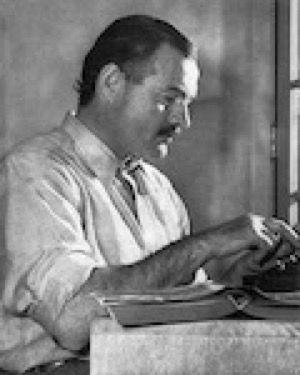
Photo Credit: Lloyd Arnold
(Wikimedia Commons)
Ernest Hemingway and Understatement
Understatement is characteristic of Hemingway. With a background in journalism, he wrote in a tight, distinctive style. His sentences are concise. His descriptions are straightforward. His dialogue is a rapid, back-and-forth delivery typical of real life.
Even when a story shows ambiguity, as seen in “Hills Like White Elephants,” a conclusion may be found in subtle narrative statements or pieces of dialogue. In a serious, though casual manner, a man is discussing abortion with his laid-back, pregnant girlfriend. He doesn’t want to push the procedure if she doesn’t want to do it. At the heart of this conversation is fear of losing freedom, as well as dread of taking responsibility for an unborn child.
The woman drinks through the scene in a Spanish cafe, and although it sounds as though both have agreed to abortion, the end hints at a different decision. “I feel fine,” she said. “There’s nothing wrong with me. I feel fine.”
Published in 1927, this frank discussion of a woman’s right to terminate a pregnancy was not typical of the decade of Prohibition and flappers. Racy feminists asserted their independence by drinking, smoking, and engaging in sex, but abortion was taboo. Hemingway’s portrayal of this woman is far from trite, even as he depicts her shrugging the matter off.
Or maybe she hasn’t. Her last statement indicates something is resolved in her mind. Asserting there’s nothing wrong could mean she has decided not to intervene, meaning no abortion. Perhaps Hemingway left his story subject to interpretation. Everyone will see a different conclusion, not a lack of resolution.
Literary Critique - Athenaise
May/17/2016 02:15 PM Filed: Literary Critiques
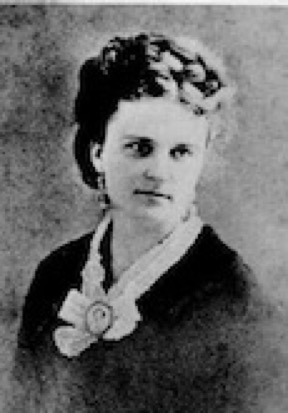
Photo Credit: Unknown
(Wikimedia Commons)
Family Ties and the Marital Obligation
Kate Chopin portrays a woman pressured into the socially acceptable norm of committed marriage in “Athenaise,” a story published in 1896. Known as a liberated go-getter, her fiction asserted a woman’s right to establish an identity separate from her husband, an act of rebellion her contemporaries considered scandalous.
By contrasting a spouse’s gentle nature with a sibling’s abrasive demeanor, Chopin emphasizes the role a male figurehead played in a woman’s life. Athenaise’s brother seems sympathetic when she abandons her husband, but he searches for serious reasons that his sister cannot provide, such as physical abuse or alcoholism.
In contrast, her husband takes rejection like a saddened gentleman, and Athenaise does not accuse. She simply leaves, an unthinkable act of defiance. This female protagonist is perceived by those around her as a flighty child controlled by her emotions. By playing devil’s advocate, Chopin makes fun of staid, paternalistic values.
Yet Chopin is far from a man-hater. Her sympathetic portrayals demonstrate that she can relate to the aborted marriage from a man’s viewpoint as well. However, she examines the undesirable nineteenth-century tendency to run a young woman out of her childhood home into the waiting arms of a husband, while discouraging freedom to live independently.
In the end, Athenaise succumbs to social pressure. The last paragraph alludes to sedated resignation of her domestic fate and sudden concern for a crying baby in a nearby cabin, which shows an instinctive maternal urge manifesting itself. Although her ambivalence may appear resolved, Athenaise did not choose the strongest course of action. She made the difficult decision to return to her husband, a responsible choice for a woman of her confining society.
Literary Critique - A&P
May/04/2016 03:15 PM Filed: Literary Critiques
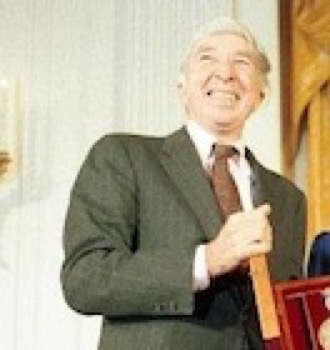
Photo Credit: George Bush Presidential Library
(Wikimedia Commons)
John Updike and the Emerging Feminist
Published in 1962, Updike’s “A&P” depicts a young grocery store clerk working during a decade when women asserted their independence by flaunting sexuality. Written in the first person, this is Sammy’s description of the events that led to his choice to quit his job in defense of a girl’s right to walk into the store underdressed.
Sammy sees all women as sexual creatures and analyzes their qualities as he works. Queenie captures his attention and sympathy when the manager reprimands her for shopping in her two-piece swimming suit.
It is Sammy’s attraction to Queenie that leads to his act of defiance. His view of her as a member of the opposite sex is typical, his reaction to her atypical. The only difference is personal, a subjective response to her body. Other women have not attracted him to the point where he would defend them in any confrontation.
Shortly after he quits and lays down his apron, Sammy looks for Queenie and her friends outside. Although he anticipates her departure, his desire to find her indicates his motivation. At the moment he makes his impulsive decision, his plan thereafter is apparent.
Sammy follows through with his rebellious statement and exits. In the end he regrets his actions and reflects, “…my stomach kind of fell as I felt how hard the world was going to be to me hereafter.”
Although it may seem ridiculous to assert that Updike encouraged emerging feminism by supporting a woman’s right to disrobe, his message in this story does point to his interest in unrestrained self-expression.
Literary Critique - The Legend of Sleepy Hollow
April/11/2016 03:26 PM Filed: Literary Critiques
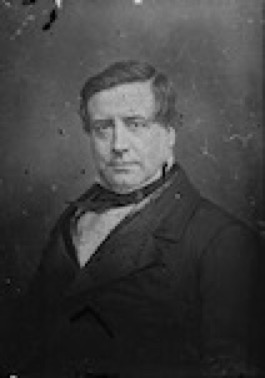
Photo Credit: Brady-Handy Collection
(Wikimedia Commons)
Washington Irving and Puritan Tradition
Irving shows the influence of Puritan superstition in “The Legend of Sleepy Hollow,” a story told from an educated man’s standpoint, with foreboding and impending doom. Like ministers of the late 1600s and early 1700s in America, the narrator reveals his outline of unfortunate events lurking on the horizon through a bone-chilling description of setting and visual details. It is possible to feel, even know, the end of this supernatural tale. The tone is negative, predictive of a life spiraling into madness and eventual annihilation.
Although recorded incidents in history, such as the Salem witch trials, were the likely catalyst for Irving’s work in 1819, he needed to create a narrator capable of building the underlying dread that captures attention. Contemporary writers have followed his tradition in paranormal, horror, and Gothic fiction.
Ichabod, an ordinary schoolmaster, can be interpreted as a symbol of a past society filled with disbelief and shock over the psychological control once exercised by the Church. As he courts a young woman and indulges in simple pleasures such as eating, enjoying the sounds and scents around him, he waits for the headless horseman and his ultimate destination. Death.
Like the Church dominated the average man, the threat of the specter on horseback arriving to claim another soul, skulks in the background. When Ichabod loses his girlfriend’s affection, he no longer has reason to rebel against his “destiny” and rides to meet his fate in the night. The protagonist’s quest for danger is a consequence of desolation and depression.
As the headless horseman pursues Ichabod, keeping pace with him in the woods, a calm acceptance instilled by a dread-filled narrator infuses the scene. The decapitated rider hurls his head at Ichabod, knocking him from his horse into the dust. Physical death follows psychological death. Ichabod’s body is never recovered.
Doubt lingers as the story closes. Did Ichabod really die, or did he start a new life elsewhere? Irving may have wished to convey a symbolical end without providing a definitive answer as to whether the nightmare by the brook was real or only a dream conceived in Ichabod’s devastated imagination.
Literary Critique - Sonny's Blues
March/30/2016 02:45 PM Filed: Literary Critiques
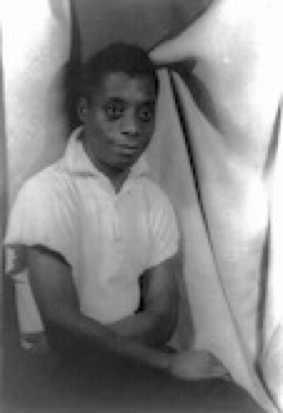
Photo Credit: Carl Van Vechten
(Wikimedia Commons)
Religious Awakening and Personal Revival
James Baldwin published “Sonny’s Blues” in 1957. It was a decade fraught with racial segregation and unrest.
Sonny is a recovering drug addict with musical talent and a dream. This is his story told from the viewpoint of his older brother. As Sonny struggles to express his God-given gift, his brother doesn’t always understand the reasons behind Sonny’s behavior. Intelligent and independent, this aspiring jazz musician finds a new life awakening through his songwriting.
The street-corner revival is symbolic of Sonny’s progression into a career as a performer. He is cool and aloof and stands apart from the women praying for rescue in their amateurish gospel tunes. Sonny’s brother observes this scene with a critical delivery.
Baldwin writes, “As the singing filled the air the watching, listening faces underwent a change, the eyes focusing on something within; the music seemed to soothe a poison out of them; and time seemed, nearly, to fall away from the sullen, belligerent, battered faces, as though they were fleeing back to their first condition, while dreaming of their last.”
As Sonny realizes his musical skill, he heals and develops a style of his own. A sense of purpose guides his life, replacing the gnawing pain. He shares his gift and inspires others to seek their personal freedom and revival.
Literary Critique - The Yellow Wallpaper
March/30/2016 01:28 PM Filed: Literary Critiques
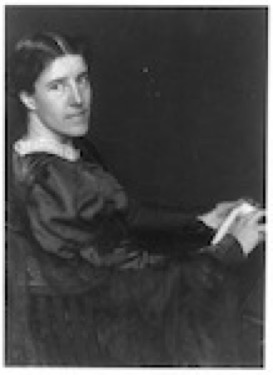
Photo Credit: Frances Benjamin Johnston
(Wikimedia Commons)
Nineteenth-Century Feminism and Suppression
“The Yellow Wallpaper” by Charlotte Perkins Gilman depicts a woman suffering a nervous breakdown. At least that’s the impression given by the character’s physician husband, who chooses to keep her in drugged confinement at a rented vacation retreat, prohibiting contact with her baby.
Based on a real incident in Gilman’s life, the story details the misery of a nineteenth-century feminist forced into a role in which she doesn’t belong. Gilman’s marriage ended, and she moved with her daughter to Pasadena, California. She pursued a career as a socialist lecturer. Although it’s unclear whether Gilman’s ex-husband kept her medicated and locked in a room, the description of the ordeal is vivid and frightening.
The protagonist appears to be hallucinating or experiencing the side effects of a powerful drug. She sees something, or someone, behind the tattered wallpaper in her bedroom, and eventually, sees her true self emerge at the end of the story. The ugly, old wallcovering alludes to the outdated, restricted life she is leaving. She announces her “arrival” to her husband because it is him she blames for being trapped.
At the end of the story she has barred herself in the bedroom and crawls on the floor removing strips of the paper. Her behavior is a symbolical metamorphosis.
Published in 1892, this strange account of domestic hell speaks of the dangers of prescribed drug abuse and unwarranted use of mind-altering medication by the medical community, as much as it shines a spotlight on a woman’s identity crisis.
Literary Critique - Bartleby the Scrivener
March/30/2016 12:59 PM Filed: Literary Critiques
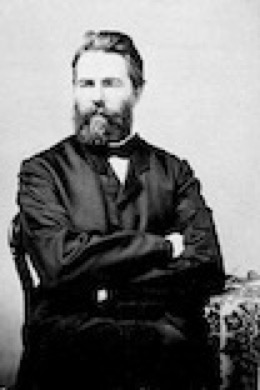
Photo Credit: Unknown
(Wikimedia Commons)
Despondency and Social Responsibility
Herman Melville raises the question of responsibility by creating an unusual character in “Bartleby the Scrivener.” Bartleby lives at an attorney’s office, yet refuses to do the simplest tasks when asked. The lawyer coaxes this funny man to cooperate, always failing. Yet the counselor cannot justify showing the obstinate fellow to the door.
Melville’s subtle sense of humor teases the reader from every page, making his audience contemplate class differences and social rebellion without offending. The subject matter may be serious, but he presents it in an entertaining light. By the end of this ridiculous tale, Bartleby is in jail, receiving special treatment at the hands of his custodians. The lawyer visits him and offers support, but his attempts are tragically futile.
Overall, the lawyer’s treatment of Bartleby is overly conscientious, perhaps exacerbating the man’s problems. The attorney’s indulgence of the scrivener’s eccentricities is nothing that a contemporary employer could understand. When the story was published in 1853, Melville may have been emphasizing the need to find solutions for the downtrodden without making American social ills worse in goodhearted attempts to correct them.
Literary Critique - The White Heron
March/30/2016 12:23 PM Filed: Literary Critiques
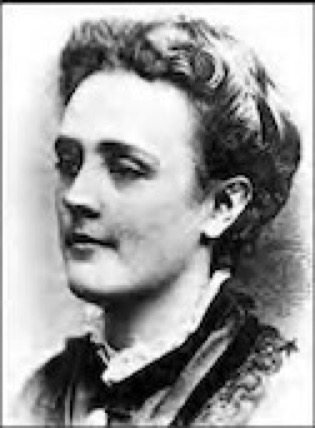
Photo Credit: Unknown
(Wikimedia Commons)
The White Heron’s Secret
In Sarah Orne Jewett’s “The White Heron” a fragile bird symbolizes freedom and faraway places the heroine has never seen. Sylvia is a compassionate woman, and her desire to protect the heron from a hunter’s gun may appear as a simple gesture to save an animal, but her inner motivation is more serious.
Early in the story Jewett writes of the green swamp grass where Sylvia caught sight of the bird. “Not far beyond were the salt marshes and beyond those was the sea, the sea which Sylvia wondered and dreamed about, but never had looked upon, though its great voice could often be heard above the noise of the woods on stormy nights.”
Jewett implies that Sylvia is a sequestered young woman preserving what she values by defending the wildlife near her home. The hunter is portrayed as indiscriminate in his use of the gun, shooting sparrows and thrushes for the thrill. His “sport” Sylvia takes to heart, and she denies him further access to her world.
On a transcendental level, she has communicated with the heron and made a pact never to disclose its whereabouts. If she had told the hunter where to find the heron’s nest, she would have betrayed herself as well as the bird, even though she could have gained the stranger’s friendship. In reality, he is nothing but an intruder.
In a mysterious bond with nature, she maintains her own right to live alongside the white heron by keeping its secret. As lonely as this existence may seem, she has won by retaining her integrity.
Literary Critique - The Storm
March/27/2016 09:27 AM Filed: Literary Critiques
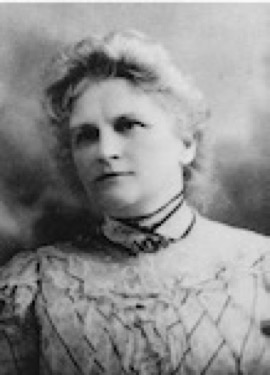
Photo Credit: Times-Picayune
(Wikimedia Commons)
Kate Chopin and the Art of Avoidance
In “The Storm” Chopin presents Alceé Laballière, a man separated from his wife and children, as he renews his friendship with Calixta, an old sweetheart, while memories of infatuation overwhelm him. They engage in sexual relations after he enters her residence during a violent storm. Their contact is sweet and sincere.
A person may be inclined to classify his behavior as infidelity until the end of the story when Chopin relates the particulars of the separation by describing an exchange of letters. The man’s wife Clarisse and his children left him for a temporary reprieve in Biloxi, Mississippi, where she could enjoy her friends without her husband’s presence. The marriage is a congenial alliance, but not an intense, sexually charged relationship.
Chopin writes, “And the first free breath since her marriage seemed to restore the pleasant liberty of her maiden days. Devoted as she was to her husband, their intimate conjugal life was something which she was more than willing to forego for a while.”
This is not what nineteenth-century society would expect to discover at the end of Alceé’s encounter. Instead of a moralizing tone, the author relates events and allows the reader to analyze. When Clarisse finds her spouse’s presence suffocating, she simply leaves. Calixta also exhibits an uninhibited sense of self, but the act of assertion is her pursuit of a married man.
A feminist, Chopin was a writer ahead of her time. Her frank portrayals of women and men going against established norms in romantic and not so romantic relationships may not seem shocking today, but in the late 1800s her thought-provoking stories jarred readers into questioning the accepted patterns of their lives. She encouraged individuality and the ability to determine the needs of the self, particularly in women, often through the art of avoidance.
The nineteenth century was the “pre-liberated” era, but Chopin had already discovered the positive and negative paths that liberation would take. She doesn’t glorify “woman” with the rabid stance of a political activist, rather she challenges everyone to think rather than act like automatons.
Literary Critique - The Magic Barrel
March/26/2016 10:06 PM Filed: Literary Critiques

Photo Credit: John Bragg
(Wikimedia Commons)
The Biblical Concept of Eve and Spiritual Love
In “The Magic Barrel” Bernard Malamud tells the story of Leo Finkle, a lonely bachelor soon to be ordained a rabbi, in his quest for true love. Leo relies on Pinye Salzman, a marriage broker, to assist him. Published in 1954, this piece is an old-fashioned version of the online dating game. Salzman is a klutzy matchmaker, and his attempts at finding a proper mate for Leo fail.
One day Leo comes upon a picture of Salzman’s daughter Stella and decides this is the woman of his dreams. At first Salzman refuses to disclose his relationship to her and will not allow Leo to meet her. In the end, persuasion wins.
This story is a basic boy-meets-girl tale, but on a deeper level Malamud describes an isolated man struggling with his need to meld sexual attraction with spiritual union, portraying a member of the clergy with a normal libido as he seeks the companionship of a woman with sex appeal, rather than the staid, conservative prospects Salzman has offered. He’s searching for his soul mate.
The final scene is significant. Leo and Stella meet on a street corner while her nervous father watches from a distance. Appealing to the rabbi is Stella’s bad girl appearance with purity in her gaze.
Malamud writes, “Stella stood by the lamp post, smoking. She wore white with red shoes, which fitted his expectations.” As she waits “uneasily and shyly,” Leo notices that her eyes are filled with “desperate innocence” and pictures “his own redemption.”
This instinctive attraction goes back to the biblical story of the Garden of Eden in which Eve is depicted as an alluring cross between ingenue and seductress. Malamud applies this mythical concept to a modern relationship.
Literary Critique - Young Goodman Brown
March/26/2016 10:02 PM Filed: Literary Critiques
Photo Credit: Mathew Brady
(Wikimedia Commons)
The Forest and the Subconscious Mind
The influence of the psychologically unstable late 1600s and the Salem witch trials are present in Nathaniel Hawthorne’s “Young Goodman Brown.”
From the viewpoint of a character such as Brown, who lived in the superstitious, devil-obsessed world of the Puritans, his behavior was justifiable. He assumed his wife was a quiet, passive woman content to stay at home as he pursued his fixations and dreams. Late one night his exploration in the woods led to more than he anticipated. Seeing his demure wife participating in what he perceived as a satanic ritual would end a romantic relationship, if not the marriage itself.
From the viewpoint of a contemporary critic, Brown’s reaction is irrational and bordering on hysteria, especially since he was seeking the same experiences and thrills that his spouse sought. People do not wander through secluded forests at night without reason. On the subconscious level, he searched for what he feared by placing himself in a situation where his buried nightmare could be realized.
Hawthorne writes, “…Goodman Brown stepped forth from the shadow of the trees, and approached the congregation, with whom he felt a loathful brotherhood, by the sympathy of all that was wicked in his heart.”
The forest is a symbol of the subconscious mind. His later withdrawing from the Puritan community alludes to Brown’s withdrawal from his own nightmare.
Literary Critique - Winter Dreams
March/25/2016 03:53 PM Filed: Literary Critiques
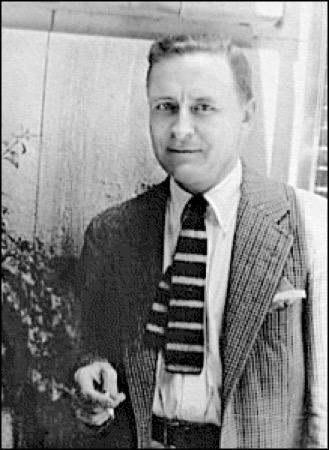
Photo Credit: Carl Van Vechten
(Wikimedia Commons)
F. Scott Fitzgerald and Dreams Unfulfilled
Fitzgerald’s “Winter Dreams” is the story of Dexter Green, a man unfulfilled. In the end he is faced with the reality that Judy Jones, his beautiful childhood sweetheart, has married someone else and “faded” into sedate, middle-class oblivion. He grieves not only for his youth and the exuberance of love, but for his inability to make decisions and pursue opportunities at the appropriate time. He denies emotion and professes immunity to grief, but this numbness is only an analgesic, a pain-relieving game he plays in his mind.
Green acknowledges that it’s too late to go back. Judy Jones is gone. In 1922, when this story was published, a woman’s marriage often signified the end of her existence. Even in a decade of emerging feminism, a conservative, confining, home-and-hearth standard hovered over the average union like a cloud over a funeral parlor.
The image of kissing Jones on Sherry Island is a mental snapshot of romance and enthusiasm. Green no longer has the spirit to live or to feel despite his lingering tears of regret. Life is “that thing” he has lost.
Fitzgerald writes, “The gates were closed, the sun was gone down, and there was no beauty but the gray beauty of steel that withstands all time. Even the grief he could have borne was left behind in the country of illusion, of youth, of the richness of life, where his winter dreams had flourished.”
Like a vibrant plant that has failed to bloom in summer due to its inability to break the soil, Green has stayed beneath the earth in a state of dormancy, where his winter dreams remained. The despondency apparent at the end of this story indicated that the man has given up. Some may interpret the end as suicidal depression, while others may see mere poetic reminiscence.
Fitzgerald wrote with purpose, and it’s unlikely that he placed his literary symbols by accident. Green’s dismal resignation from life may stand for traditional society conforming to an outdated pattern of living established by past generations. Perhaps this is why Fitzgerald and his contemporaries were known as the “lost generation” as they searched for meaning in life.
ForeWord Review - How to Make a Soul
March/11/2016 01:59 PM Filed: ForeWord Reviews
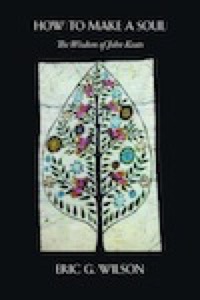
Part literary criticism and part memoir, this empathetic analysis of renowned poet John Keats probes the hidden nature of spirituality. Keats believed the human soul is created. It is on this premise that Wilson builds his scholarly evaluation. The book also serves as a biographical record, incorporating events that impacted Keats with the greatest intensity, crucial points that altered the course of his existence.
ForeWord Review - 10 Women
March/10/2016 02:50 PM Filed: ForeWord Reviews

This off-the-wall collection of character sketches paints eccentric women in darkening shades of realism. Forbidden interludes, experiences that awaken, and pondering disclosures fill the pages of Bowering’s unique book. His literary escapades enlighten and entertain, allowing an eye-opening glimpse of liaisons that do not always play by an established set of rules.
ForeWord Review - Arrivals and Departures from Normal
February/05/2016 02:43 PM Filed: ForeWord Reviews
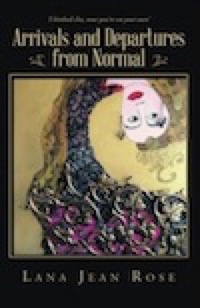
This candid view of the art world from the perspective of an ambitious woman will enthrall, and perhaps frighten, creative audiences. A gifted artist faced with formidable obstacles exceeds expectations in this mesmerizing, true-to-life story. Rose captivates and inspires, allowing an intimate look at what it takes to succeed in a competitive profession, while delving into the complicated realm of self-expression for public consumption.
ForeWord Review - Under the Pong Pong Tree
January/15/2016 04:43 PM Filed: ForeWord Reviews

The Japanese invasion of Singapore sets the backdrop for this World War II saga of loyalty, love, and the promise of liberation. Levey delves into the brutality of foreign occupation from a woman’s perspective, allowing a candid portrayal of a victim to emerge from the pages of this gritty chronicle. The novel humanizes the experiences by providing frank and unpleasant details in prose that is sensitive, knowledgeable, and empathetic, covering intriguing topics across an extensive time line.
ForeWord Review - Smooth
January/12/2016 01:06 PM Filed: ForeWord Reviews
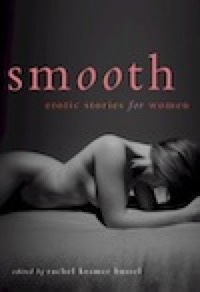
An anthology of nineteen pieces written by a diverse group of women, this collection is attention-grabbing and titillating, though it occasionally verges on esoteric. The theme is one of revelation and discovery. The stories explore a wide range of unusual scenarios, with only a few falling into the realm of the stereotypical or trite. Edited by an award-winning erotica editor, this book is outstanding and original.
ForeWord Review - The Flower Bowl Spell
January/08/2016 09:00 AM Filed: ForeWord Reviews

An eccentric cross between literary quirkiness and young adult fiction, this carefully crafted novel illuminates what the uninitiated human cannot fathom: fairies, auras, and spells. A fine command of language is evident throughout this lighthearted story. Boler writes with precision, placing every word like a dollop of color on a canvas. Enter an enchanted mindscape where inanimate objects come to life and mythological beings appear out of nowhere. Her narrative transforms urban terrain into mystical wonderland.
ForeWord Review - Conversations with Bob
January/05/2016 06:00 PM Filed: ForeWord Reviews

Catastrophic scenarios and dire predictions are often proven incorrect, an astounding historical phenomenon that Gentle explores in four creative interviews. This concise documented book is nonfiction with a fictional twist, placing the hero of this story in a time capsule that allows him to communicate with pessimists from the eighteenth, nineteenth, and twentieth centuries. Knowledge is limited to the era in which we live. Consequently, determining what will happen in the next century, or even the next decade, may not be possible.
